VIA's Dual Core Nano & VN1000 Chipset Previewed
by Anand Lal Shimpi on November 15, 2010 12:26 PM ESTGraphics Performance: Surprisingly Potent
Preparing to test the VN1000 was a lot like deciding to go see a John Cusack movie. You assume it’s going to be bad, but every now and then you might be pleasantly surprised. My expectations were thus very low.
The last VIA platform I had wouldn’t complete most 2D benchmarks in Windows 7 due to driver issues and general instability. That’s why you only see a few scores from the old Nano in Bench. The VN1000 was completely different.
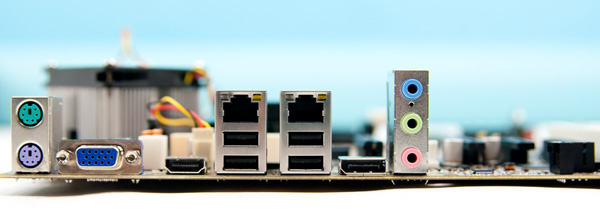
The VIA VN1000 Reference Board featured VGA, HDMI and DP outputs
Despite the typical omg-thisisntATI/NVIDIA error that some games always throw, the VN1000 actually ran everything I threw at it. I didn’t notice any rendering errors or any driver compatibility problems. I didn’t run every last title on the market, but I ran a number that I honestly didn’t expect VIA to be able to handle. And the VN1000 did.
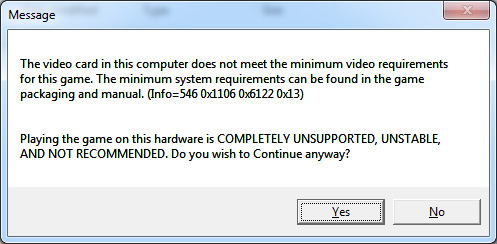
Dragon Age, Modern Warfare 2, BioShock 2, World of Warcraft and even Starcraft II all ran on the VN1000. Not only did they run, but some of them actually ran pretty well.
As with all integrated graphics I had to test at the lowest possible quality settings at 1024 x 768 across virtually all titles. I should add that although the Chrome 520 GPU does support H.264 acceleration, I couldn't get it working with the driver drop I had on my test platform. CPU utilization would be low but I still dropped frames. I suspect this is a driver or software compatibility issue which I do expect VIA to rectify before the platform ships.
First let’s compare directly to Atom and ION:
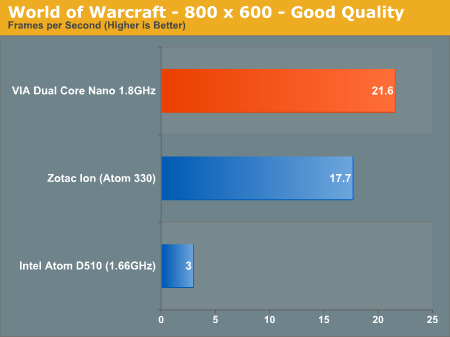
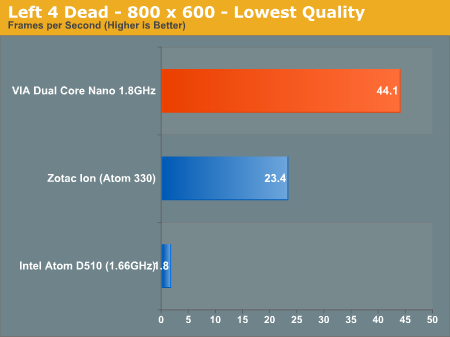
The Atom comparison is dramatic. Intel hasn’t taken GPU performance seriously for years and Atom was the last example of that mentality. What’s even more surprising however is that the Chrome 520 GPU is actually faster than NVIDIA’s ION.
Clearly the VN1000 can hold its own in the Atom space, so let’s set our sights a little higher. How about Clarkdale?
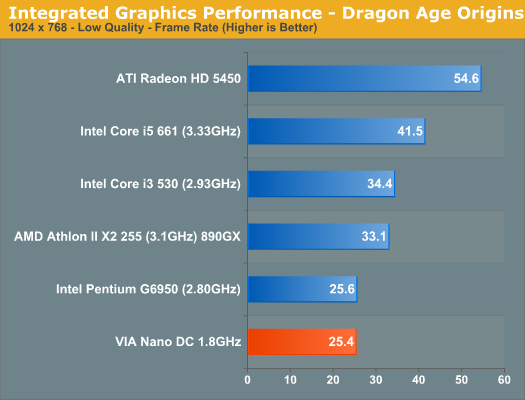
Under Dragon Age Clarkdale puts VIA in its place. The Core i3 manages a 40% performance advantage here. But look at a lower end competitor: the Pentium G6950 is no faster than the dual core Nano/VN1000 platform!
It gets even more ridiculous under Modern Warfare 2:
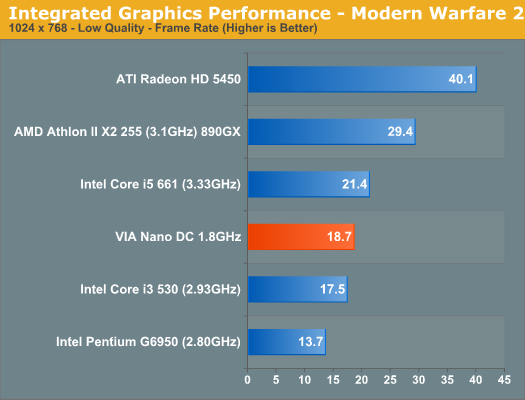
VIA’s platform is actually faster than Intel’s Core i3 with integrated graphics. The same holds true under World of Warcraft:

Here the Nano is able to even equal the performance of the Core i5 661. Pretty impressive.
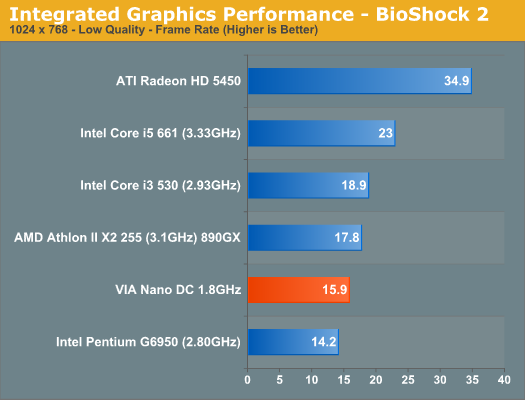
The VIA platform didn't handle BioShock 2 very well, but it's still able to get the Pentium G6950 a run for its money.
I was particularly curious to see how Starcraft II ran on the platform. Starcraft II can be both GPU and CPU limited within a single play session simply depending on what you're doing. Scrolling around the map and just watching your units gather resources tends to be GPU bound on mainstream or faster systems. Big battles however are almost always CPU bound. To showcase both we have two benchmarks. Our GPU test is a 2v2 with a lot of scrolling around the map, while our CPU test is a 3v3 monitoring frame rate during a huge battle involving all of the players.
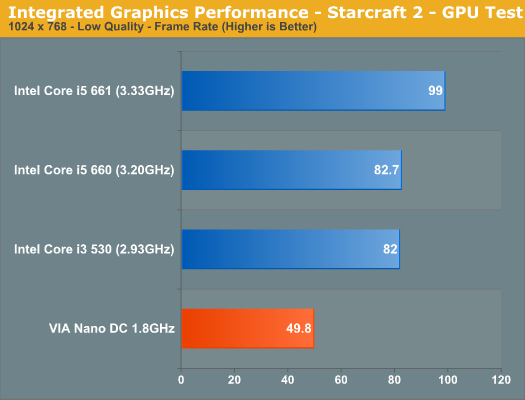

VIA's Chrome 520 is definitely fast enough for Starcraft II. At low quality settings, the VIA platform can manage nearly 50 fps in our GPU test. That translates into smooth gameplay while moving around a map and selecting units. It's the CPU that's holding back the platform. In large battles the Nano DC drops down below 10 fps and choppiness ensues. Intel's Clarkdale graphics enjoys around 2x the performance in our CPU test and about 60% higher frame rates in the GPU test. Intel has done a lot of work with Blizzard optimizing for SC2, so strong performance here isn't surprising.
Overall, you can color me impressed. This is real world, usable performance. Even the experience under Windows wasn’t half bad. Moving windows around was sometimes choppy but for the most part it could’ve been any other integrated graphics platform that I was using. Drivers installed fine and I didn’t get any strange crashes or compatibility errors during my limited testing period.
I have to say that this is probably the first VIA platform that has delivered not only competitive but impressive graphics performance in years. Let’s take a look at the CPU performance.










54 Comments
View All Comments
ckryan - Monday, November 15, 2010 - link
I recongnize that some people may totally write VIA off in this market, but don't overlook the fact that an improved shipping model of this board could at least cause Intel to rethink its Atom strategy. I really wanted an Atom system for a while, but then I realized for the same price as the setup I wanted, an i3/gigabyte mini itx system would be about the same price. A stripped down Atom board from Intel wouldn't be worthwhile at all, even if it is $80. In the business and mobile spaces, Atoms make a good argument. Its just a stale argument. AMD and VIA bringing more options to the market can't be called a bad thing. My hope is not just that VIA doesn't fail entirely, but that I have lots of interesting options in the near future.DanNeely - Tuesday, November 16, 2010 - link
Intel definitely could use a chip midway between the current atom and CULV product lines. The dual core atoms don't really help much; yeah they're better at decoding video that the GPU doesn't support, but the atoms general performance problems are single threaded in nature.Clocking the chip up to ~2.5ghz would probably help a good bit there but would probably blow the power budget out of the water.
Intel's stated that atom will remain in order for at least the first 4-5 years, so we shouldn't expect this to change. With intel primarily aiming atom at Arm's market share something that adds a lot of complexity to the chip is probably out of the question anyway.
A more efficient memory controller connection might help. The current implementation is on die FSB so there's definite room to improve here. How much this would help is something of an open question though. Outside of memory bound benchmarks the ~2x latency difference between the directly connected and on die FSB controllers in lga 1366 vs 1156 i7's wasn't very large; but as an in order CPU with a tiny cache memory latency is a bigger impact on the atoms performance, although this is partially balanced by it having a much lower load on the memory sub system due to is generally slow performance This might be the easiest place for Intel to speed things up though.
Alternatively the runtime gap between atom and CULV isn't that large, it might be possible to push it down into the current atoms power envelope even at atom drops into the higher end part of Arms territory.
danacee - Monday, November 15, 2010 - link
I remember reading an article last year from digit life that you can get some pretty massive performance gains on a Nano just by tricking your windows install into thinking its Intel. Seens the code handed to the nano is pretty shoddy even next to AMD.Anand, to get a true representation of the nano's performance I'm afraid you will have to do a cpu-z hack.
danacee - Monday, November 15, 2010 - link
found it;http://ixbtlabs.com/articles3/cpu/via-nano-cpuid-f...
sprockkets - Monday, November 15, 2010 - link
Why is there a "ATI Radeon HD 5450" in the power consumption graphs? That makes no sense. Where is the Athlon X2 3250e?Should compare the processor in this system, the Neo X2, if different:
http://www.newegg.com/Product/Product.aspx?Item=N8...
yuhong - Monday, November 15, 2010 - link
"Despite the typical omg-thisisntATI/NVIDIA error that some games always throw,"NT 4's CPUID code was full of such problems:
http://geoffchappell.com/viewer.htm?doc=studies/wi...
Even more recently, 64-bit Windows has a hardcoded list of CPU vendors it will run on, and will BSoD with UNSUPPORTED_PROCESSOR on any other vendor. An update had to be released to add CentaurHauls to the list.
Is there an option in the BIOS to fake a GenuineIntel CPU vendor?
Oxford Guy - Tuesday, November 16, 2010 - link
A fair and competitive marketplace!mschira - Monday, November 15, 2010 - link
The complete Via CPU story - long before they named it Nano - is essentially a story of not delivering.All these jesaya and what not platforms one could never really by them.
And yes Nano looks nice, the single core one didn't look to bad a year ago. But where is anything build with it that one can buy?
More competition? Great! but please make it to market.
Maybe now is the time Nvidia buys VIA.
M.
jo-82 - Tuesday, November 16, 2010 - link
Sorry, but my old Epia C7 sucks only 25W from the socket, and its fast enough for the job.LoneWolf15 - Tuesday, November 16, 2010 - link
When VIA comes out with a product, I really want to like it, and I want them to succeed. I actually got a cheapie notebook for a parent with a C7-M processor that worked well for quite some time until their needs grew. That said, here are my two issues."I should add that although the Chrome 520 GPU does support H.264 acceleration, I couldn't get it working with the driver drop I had on my test platform. CPU utilization would be low but I still dropped frames. I suspect this is a driver or software compatibility issue which I do expect VIA to rectify before the platform ships."
VIA (or should I say S3) has had many times where a graphics driver with bugs or compatibility issues that have delayed a product's potential after its release until it is no longer competitive with newer offerings. If the bugs aren't fixed at initial product release (I hope they are, but from experience...) that would be a huge strike against this.
"The DC Nano platform I tested is built on an old 65nm manufacturing process at TSMC. As a result, power consumption isn't that great. Also note that VIA doesn't do any power gating, so idle power ends up being very similar to Clarkdale"
If the Nano had power consumption that beat AMD but lost to Intel, I think we'd all be excited. Heck, if it matched AMD but with lower heat output, I think I still would be. However, we're looking at a product that cannot beat a Core i3 in performance, that equals it in power consumption. I think not doing power gating is a huge mistake here.
I hope the released product has the driver issue fixed, and I hope VIA can consolidate their architecture (i.e., turn a 2-core Nano into an SoC or at least a partial SoC) for power savings, lower expense, and maybe performance improvement. That said, I'll also believe it when I see it.